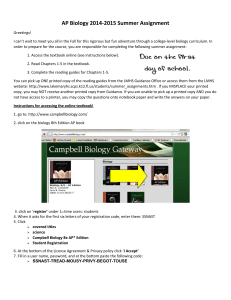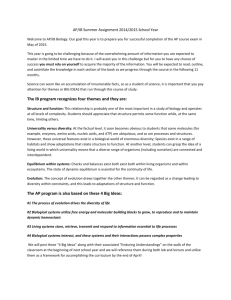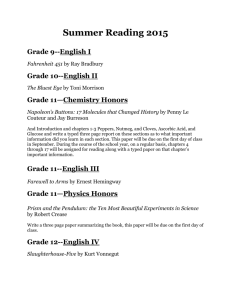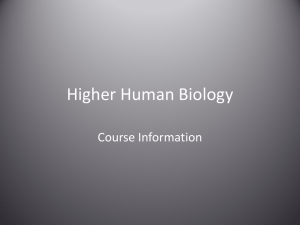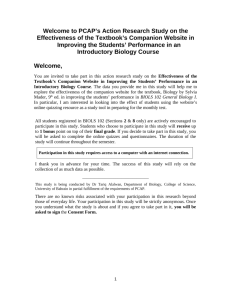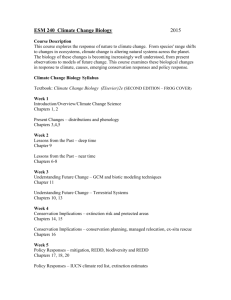AP Biology Summer Assignment 2015-2016
advertisement
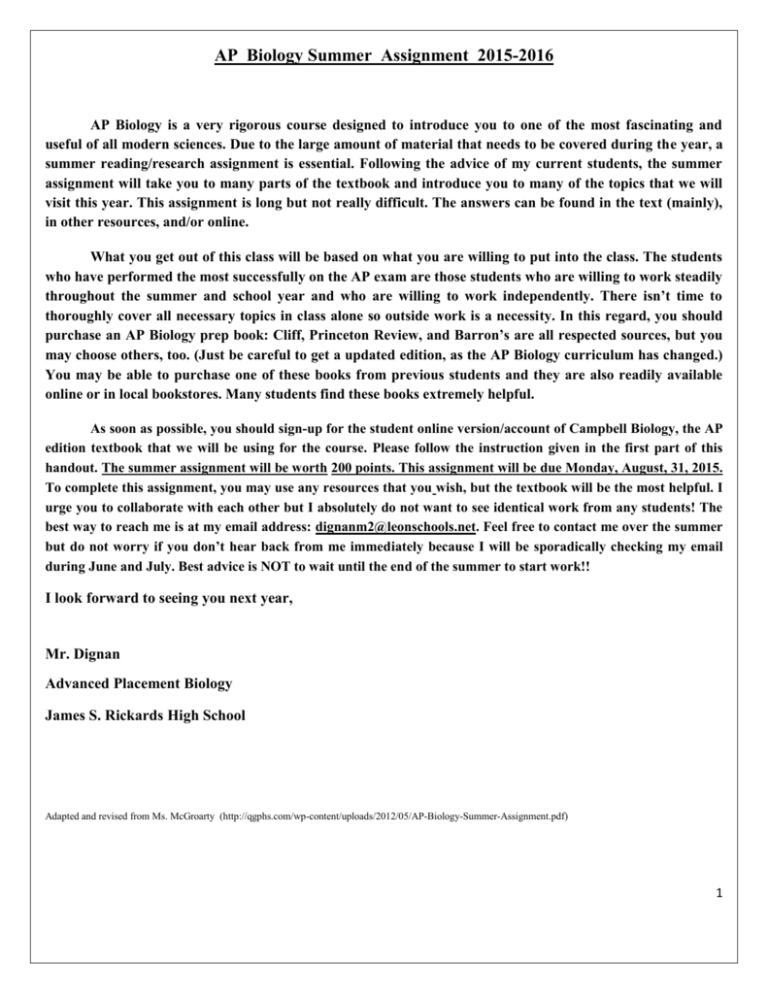
AP Biology Summer Assignment 2015-2016 AP Biology is a very rigorous course designed to introduce you to one of the most fascinating and useful of all modern sciences. Due to the large amount of material that needs to be covered during the year, a summer reading/research assignment is essential. Following the advice of my current students, the summer assignment will take you to many parts of the textbook and introduce you to many of the topics that we will visit this year. This assignment is long but not really difficult. The answers can be found in the text (mainly), in other resources, and/or online. What you get out of this class will be based on what you are willing to put into the class. The students who have performed the most successfully on the AP exam are those students who are willing to work steadily throughout the summer and school year and who are willing to work independently. There isn’t time to thoroughly cover all necessary topics in class alone so outside work is a necessity. In this regard, you should purchase an AP Biology prep book: Cliff, Princeton Review, and Barron’s are all respected sources, but you may choose others, too. (Just be careful to get a updated edition, as the AP Biology curriculum has changed.) You may be able to purchase one of these books from previous students and they are also readily available online or in local bookstores. Many students find these books extremely helpful. As soon as possible, you should sign-up for the student online version/account of Campbell Biology, the AP edition textbook that we will be using for the course. Please follow the instruction given in the first part of this handout. The summer assignment will be worth 200 points. This assignment will be due Monday, August, 31, 2015. To complete this assignment, you may use any resources that you wish, but the textbook will be the most helpful. I urge you to collaborate with each other but I absolutely do not want to see identical work from any students! The best way to reach me is at my email address: dignanm2@leonschools.net. Feel free to contact me over the summer but do not worry if you don’t hear back from me immediately because I will be sporadically checking my email during June and July. Best advice is NOT to wait until the end of the summer to start work!! I look forward to seeing you next year, Mr. Dignan Advanced Placement Biology James S. Rickards High School Adapted and revised from Ms. McGroarty (http://qgphs.com/wp-content/uploads/2012/05/AP-Biology-Summer-Assignment.pdf) 1 AP Biology Summer Assignment 2015-16 Teacher: Mr. Dignan (dignanm2@leonschools.net) The summer assignment should be placed in a one-inch diameter three-ring notebook with tabbed and labeled dividers separating each of the three parts. You should type all of the questions and write your answers, by hand, below the questions. DO NOT PUT THE QUESTIONS ON ONE PAGE AND THE ANSWERS ON ANOTHER PAGE. An electronic copy of the assignment can be emailed to you and it will also be available on the schools’ website. A suggestion is to look over the questions first and estimate the amount of space that you will need for each answer. Then, insert spaces between the questions before you print them. Write neatly; if I can’t read your writing I can’t give you credit for your answers. Please do not put your pages in page protectors! Additional Information: Start the summer assignment early and do not try to do the whole project at one time! A better strategy is to do smaller parts of the project over a longer period of time. Grading rubric: Sections will be scored as shown on the rubric. You will earn points for detail, completeness, and depth of thought. To earn the full points, you will need to have adequately addressed all parts of each question. Please print the grading rubric and use it as the title page for your notebook. I will not grade your notebook without this page. Proper format includes the following: Notebook and dividers as described above, rubric in front, typed questions with hand-written answers; All questions and answers presented in numerical order within each section; SKIPPING LINES BETWEEN EACH QUESTION; and neatness. The major purpose of this summer assignment is to introduce you to the wide spectrum of modern biology and to familiarize you with your textbook and other relevant resources that you may be using throughout the year. This book contains a LOT of information. We will not be covering EVERYthing in the book so don’t get overwhelmed as you work your way through the text. Most, but not all, chapters will be covered in the summer assignment. Do a good job on this assignment. The grade can be a big boost to your first quarter grade and it will also be a good review guide for the AP exam. The textbook is big and heavy so take advantage of the online version of the textbook. It is a very well-written book, though, and students who read carefully can and do learn quite a bit. Don’t overlook the illustrations, charts, and graphs….they can be very helpful. 2 AP Biology Summer Assignment 2015-16 Grading Rubric Name: Period: Date: Part 1 2 Comments Points Possible Chapter Explorations Unit 1 20 Unit 2 20 Unit 3 30 Unit 4 12 Unit 5 26 Unit 6 10 Unit 7 20 Unit 8 12 Big Ideas 24 Points Earned “Immortal Life of Henrietta Lacks” 3 Summary Report 16 Format 10 TOTAL 200 3 Part I – Chapter Explorations – START EACH UNIT ON A NEW PAGE The assignments in the chapters are not meant to be inclusive of all of the major topics that we will discuss in class this year. The assignments will give you an overview of the field of biology. Unit 1: The Chemistry of Life – 1. Ch. 2 - Write the key concepts from chapter 2 (include the concept number, also). These are listed for you in the front of the chapter. 2. Ch. 3 -Use illustrations to describe how the structure of a water molecule allows it to form hydrogen bonds with other water molecules. 3. Ch. 4 - We are called “carbon-based life-forms.” What about the carbon atom makes it an ideal atom to form the “backbone” or skeleton for most biological compounds? 4. Ch. 5 - Fill in the blanks in the table describing the 4 main groups of organic compounds in living things. Compound Carbohydrates Atoms found in all members of this group Major purposes Examples Lipids Proteins Long-term energy storage, regulation Regulation, transport, protection, structural support Nucleic Acids C, H,O, N, P Sugars, starches, cellulose, chitin Unit 2: The Cell 1. Ch. 6 – Describe the similarities and differences between prokaryotic and eukaryotic cells. Then, select 3 eukaryotic cell organelles that you think you will enjoy studying. For each one, draw and explain the function of this organelle and tell what you find most interesting about it. 2. Ch. 7 – Describe the differences between passive and active transport. For each of these types of cell transport, describe several different examples. 3. Ch. 8 – What is metabolism? Describe how ATP and enzymes are related to metabolism. 4. Ch. 9 – In your own words, describe the major purpose of cellular respiration. Also, find a website that describes a lab activity that could be used to study the rate of cellular respiration. Select a site and an activity that is something that you understand and that would be appropriate for high school or younger students. Briefly describe the activity and be sure to include the website address in your answer. 5. Ch. 10 – Describe the importance of photosynthesis to life on earth. 6. Ch. 12 – Find and view a website that animates or illustrates the steps of a normal eukaryotic 4 cell cycle. Then, describe how cancer and the cell cycle are related. If you can find a website that illustrates cancer formation, explore and include this, too! Unit 3 – Genetics 1. Ch. 13 –Compare and contrast sexual and asexual reproduction and list the advantages and disadvantages of each type of reproduction. Also, describe the most significant differences between mitosis and meiosis. 2. Ch. 14 – Look through chapter 14 (and/or any other resources related to Mendelian genetics) and use the information to answer the following questions: a. In Goozels (mythical creatures), wheelshaped legs are dominant to stickshaped legs. Two heterozygous wheel-legged Goozels mate and have 12 little Goozels. How many (if any) of these offspring should have stick-legs? Select appropriate symbols and show your work. b. What do you think will be the most interesting topic to study in this chapter? Explain. 3. Ch. 15 – describe a chromosome. Then describe a genetic condition (such as Down Syndrome) that can result when chromosomes don’t separate correctly during meiosis. 4. Ch. 16 – a. What is the role of DNA in living things? b. Describe the structure and parts of a DNA molecule. c. Briefly, describe how DNA replicates. Use illustrations. 5. Ch. 17 – a. Describe the relationship between genes and proteins. B. Compare and contrast the structures and functions of DNA and RNA. 6. Ch. 18 – Compare and contrast viruses and bacteria. Describe some diseases caused by each type of microbe. Are viruses living things? Explain your answer. 7. Ch. 20 – This chapter describes a number of research techniques that are used to study genetics and DNA. Describe ONE of these techniques and describe what types of things we can learn from using this technique. Find, visit, and list a website that describes or simulates the technique that you chose. 8. Ch. 21 – Describe how mammals can be cloned. Humans are mammals but,so far, no humans have been successfully cloned. Do you think we should try to clone humans? Defend your position. Unit 4: Mechanisms of Evolution 1. Ch. 22 – This is the introductory chapter for the evolution unit. Look through the topics covered in this chapter and describe the ones that you think will be most interesting to study. Explain your choices. 2. Ch. 23 – why are populations considered to be the smallest unit of evolution? Explain the roles of mutation and sexual recombination in the process of evolution. 3. Ch. 24 – a. Discuss the biological species concept. b. Reproductive isolation is one of the major processes that keeps species separate from each other. Distinguish between pre-zygotic and post-zygotic barriers that contribute to reproductive isolation and provide an example of each. 5 Unit 5: The Tree of Life – Introduction to Biodiversity 1. Ch. 26 – Describe how scientists think the first eukaryotic cells were formed (endosymbiosis theory). 2. Ch. 27 – Prokaryotes can have both harmful and helpful impacts on humans. List and describe 2 harmful and 2 helpful impacts. 3. Ch. 28 – Protists are the most nutritionally diverse of all eukaryotic organisms. Describe some of the methods by which different protists get their food (find this in the first few pages of the chapter but look through the chapter to get an idea about the great diversity of this group). 4. Ch. 29-30 – Members of the plant kingdom range from very simple to very complex organisms. Order these groups of plants from simplest to most complex and give a brief description of each group as well as at least one example of each group: Angiosperm, bryophyte, gymnosperm, pterophyte. 5. Ch. 31 – Fungi are heterotrophs that feed by absorption and they are very important to humans. Name and describe 2 types of pathogenic fungi and 2 beneficial uses of fungi. 6. Ch. 32 – Describe the concept of “animal” –briefly mention nutritional mode, cell structure and specialization, reproduction and development. 7. Ch. 33 – What is an invertebrate animal? If you had to be locked in a room with an invertebrate, which phylum would you MOST like to be with and which phylum would you LEAST like to be with? Justify your selections. 8. Ch. 34 – a. You are a vertebrate animal in the class Mammalia. If you could be any other type of nonmammalian vertebrate animal, what would you be? Explain why. b. A number of characteristics distinguish humans from other hominids. Describe these characteristics. Unit 6 – Plant Form and Function 1. Ch. 35-39 – Look through these 5 chapters and find TWO concepts (identified in blue and red by concept number – such as concept 35.1 on p. 713) that you think you will enjoy studying. Briefly describe this concept and explain why it appeals to you. You only need to find 2 within the 5 chapters, NOT 2 per chapter. Unit 7 – Animal Form and Function 1. Ch. 40-49 – look through these 10 chapters (during the year, we will cover some parts of all of these chapters but not all 10 in detail!). Select the FOUR chapters that you think you will most enjoy studying. For each chapter, briefly describe the purposes and major structures of the body systems featured. Also, describe what about these particular chapters’ appeals to you. Unit 8 - Ecology 1. Ch. 50-55 – Ecology is the study of interactions between organisms and the environment. These interactions are critical to keeping us alive. Look through each chapter and list the single concept within each chapter that you think is the most important concept in the chapter (for each chapter, write the concept and the concept number). 6 Part II – Big Ideas in Biology You have just finished looking through your entire textbook. For each of the big ideas listed below, think about what they mean, and then look through your textbook to find chapters that you think are related to the big ideas. Under each big idea, list each chapter that you think contains topics that exemplify that big idea. W rite a specific, justification for why you think these particular chapters should be included under that big idea. You do not need to write a justification for each individual chapter, but summarize why you chose that group of chapters and cite a few specific examples. You may find that a chapter goes with more than one big idea. Reading chapter 1 will give you a good feel for some of these topics. Big Idea 1: The diversity and unity of life can be explained by the process of evolution. Big Idea 2: Biological systems use energy and molecular building blocks to grow, reproduce, and maintain homeostasis (regulation). Big Idea 3: Living systems store, retrieve, transmit, and respond to information critical to life processes. Big Idea 4: Biological systems interact, and these interactions possess complex properties. Part III – Summary Book Report Read the book “Immortal Life of Henrietta Lacks and write a report. A. The report should include: 1. One page = 150 words, double spaced, times new roman font, 12 size and standard borders) 2. A summary of the story (1- page. Not from reviews of the book) 3. Reflections about the book (1 page, I am interested in your opinions and thoughts. Your reflection should deal directly with topics from the text) WARNING Reports are NOT a team effort and they must be written in your own words. Do not cut and paste summary information off the internet. NO Plagiarism (Penalty = a grade of F for the course) 7 AP Biology Online Registration Instructions AP Biology Online Registration Instructions Please use the access code only once to create a username and password because multiple attempts deletes attempts and slots for other students. Once you have gained access and let's say you forget your password or username do not attempt to register again. Please either use the "I forgot my password/username" tag or call Pearson Technical support for assistance. 1. Register at www.pearsonschool.com/access 2. Your code(s) begin with the letters SS -- (SSNAST) 3. Click on Covered Titles to Select Discipline and Title Select Cover Title: “Science” o ‘Campbell, Biology 8e *AP Edition 4. Choose Student Registration 5. Accept - Pearson License Agreement 6. Access Information * Create username & password * Enter the Student Access Code below: SSNAST-WHIRR-SKELF-TURVY-SAPIR-SIRES 7. Account Information – complete your name & school information. (When entering “Account Information,” in the section for ‘School Name’ then select ‘Other’ and type in “James S. Rickards” and the remaining school information). 8. Confirmation & Summary – link to login and join a class. (Under this section select the tab “Join A Class) Do not attempt to register or enter the class ID into the “Course ID” tab Class code: The Class ID is RHSAPB2015 To sign up for Class: AP Biology I 8
